

Wheeler's delayed choice experiment. Wheeler's delayed choice experiment is actually several thought experiments in quantum physics, proposed by John Archibald Wheeler, with the most prominent among them appearing in 1978 and 1984.[1] These experiments are attempts to decide whether light somehow "senses" the experimental apparatus in the double-slit experiment it will travel through and adjusts its behavior to fit by assuming the appropriate determinate state for it, or whether light remains in an indeterminate state, neither wave nor particle, and responds to the "questions" asked of it by responding in either a wave-consistent manner or a particle-consistent manner depending on the experimental arrangements that ask these "questions.
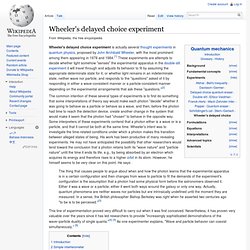
"[2] This line of experimentation proved very difficult to carry out when it was first conceived. Nevertheless, it has proven very valuable over the years since it has led researchers to provide "increasingly sophisticated demonstrations of the wave–particle duality of single quanta. Delayed choice quantum eraser. A delayed choice quantum eraser, first performed by Yoon-Ho Kim, R.
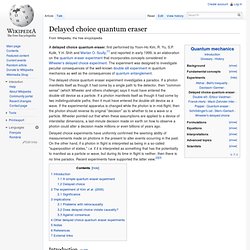
Yu, S.P. Kulik, Y.H. Shih and Marlan O. Quantum eraser experiment. Elitzur–Vaidman bomb tester. Bomb-testing problem diagram.
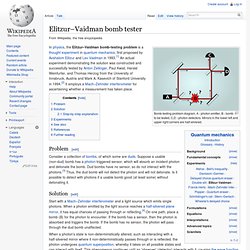
A - photon emitter, B - bomb to be tested, C,D - photon detectors. Mirrors in the lower left and upper right corners are half-silvered. In physics, the Elitzur–Vaidman bomb-testing problem is a thought experiment in quantum mechanics, first proposed by Avshalom Elitzur and Lev Vaidman in 1993.[1] An actual experiment demonstrating the solution was constructed and successfully tested by Anton Zeilinger, Paul Kwiat, Harald Weinfurter, and Thomas Herzog from the University of Innsbruck, Austria and Mark A.
Kasevich of Stanford University in 1994.[2] It employs a Mach–Zehnder interferometer for ascertaining whether a measurement has taken place. Problem[edit] Consider a collection of bombs, of which some are duds. Solution[edit] Start with a Mach–Zehnder interferometer and a light source which emits single photons. Schrödinger's cat. Schrödinger's cat: a cat, a flask of poison, and a radioactive source are placed in a sealed box.
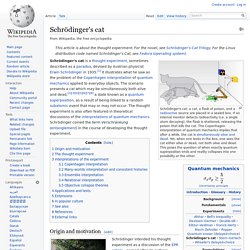
If an internal monitor detects radioactivity (i.e. a single atom decaying), the flask is shattered, releasing the poison that kills the cat. The Copenhagen interpretation of quantum mechanics implies that after a while, the cat is simultaneously alive and dead. Yet, when one looks in the box, one sees the cat either alive or dead, not both alive and dead. This poses the question of when exactly quantum superposition ends and reality collapses into one possibility or the other. Schrödinger's cat is a thought experiment, sometimes described as a paradox, devised by Austrian physicist Erwin Schrödinger in 1935.[1] It illustrates what he saw as the problem of the Copenhagen interpretation of quantum mechanics applied to everyday objects.
Origin and motivation[edit] Real-size cat figure in the garden of Huttenstrasse 9, Zurich, where Erwin Schrödinger lived 1921 – 1926. Schrödinger wrote:[1][10] Popper's experiment. Popper's experiment is an experiment proposed by the philosopher Karl Popper.

As early as 1934 he was suspicious of, and was proposing experiments to test, the Copenhagen interpretation, a popular subjectivist interpretation of quantum mechanics.[1][2] Popper's experiment is a realization of an argument similar in spirit to the thought experiment of Einstein, Podolsky and Rosen (the EPR paradox) although not as well known. There are various interpretations of quantum mechanics that do not agree with each other. Despite their differences, they are experimentally nearly indistinguishable from each other. Bell test experiments. Bell test experiments or Bell's inequality experiments are designed to demonstrate the real world existence of certain theoretical consequences of the phenomenon of entanglement in quantum mechanics which could not possibly occur according to a classical picture of the world, characterised by the notion of local realism.
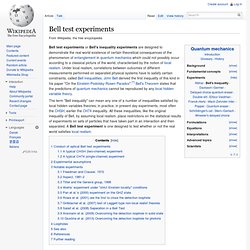
Under local realism, correlations between outcomes of different measurements performed on separated physical systems have to satisfy certain constraints, called Bell inequalities. Stern–Gerlach experiment. Basic theory and description[edit] Quantum spin versus classical magnet in the Stern–Gerlach experiment Basic elements of the Stern–Gerlach experiment.
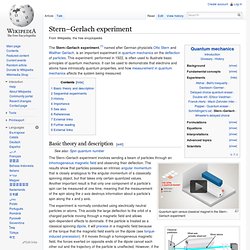
The Stern–Gerlach experiment involves sending a beam of particles through an inhomogeneous magnetic field and observing their deflection. The results show that particles possess an intrinsic angular momentum that is closely analogous to the angular momentum of a classically spinning object, but that takes only certain quantized values. Davisson–Germer experiment. History and Overview[edit] According to Maxwell's equations in the late 19th century, light was thought to consist of waves of electromagnetic fields and matter was thought to consist of localized particles.
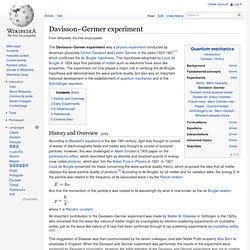
However, this was challenged in Albert Einstein’s 1905 paper on the photoelectric effect, which described light as discrete and localized quanta of energy (now called photons), which won him the Nobel Prize in Physics in 1921. In 1927 Louis de Broglie presented his thesis concerning the wave-particle duality theory, which proposed the idea that all matter displays the wave-particle duality of photons.[2] According to de Broglie, for all matter and for radiation alike, the energy E of the particle was related to the frequency of its associated wave ν by the Planck relation: And that the momentum of the particle p was related to its wavelength by what is now known as the de Broglie relation: where h is Planck's constant.
Early Experiments[edit] Experimental setup A breakthrough[edit] R. Double-slit experiment. The double-slit experiment is a demonstration that light and matter can display characteristics of both classically defined waves and particles; moreover, it displays the fundamentally probabilistic nature of quantum mechanical phenomena.
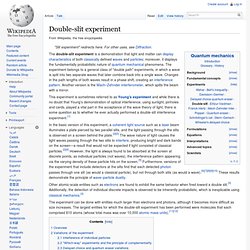
The experiment belongs to a general class of "double path" experiments, in which a wave is split into two separate waves that later combine back into a single wave.